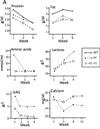Human milk for the premature infant
- PMID: 23178065
- PMCID: PMC3508468
- DOI: 10.1016/j.pcl.2012.09.008
Human milk for the premature infant
Abstract
Premature infants are at risk for growth failure, developmental delays, necrotizing enterocolitis, and late-onset sepsis. Human milk from women delivering prematurely has more protein and higher levels of bioactive molecules. Human milk must be fortified for premature infants to achieve adequate growth. Mother's own milk improves growth and neurodevelopment, decreases the risk of necrotizing enterocolitis and late-onset sepsis, and should be the primary enteral diet for premature infants. Donor milk is a resource for premature infants whose mothers are unable to provide an adequate supply of milk. Challenges include the need for pasteurization, nutritional and biochemical deficiencies, and limited supply.
Copyright © 2013 Elsevier Inc. All rights reserved.
Conflict of interest statement
Conflict of interest: none
Figures


References
-
- Martin J, Hamilton B, Ventura S, Osterman M, Wilson E, Mathews T. Births: final data for 2010. Natl Vital Stat Rep. 2012;61(1) - PubMed
-
- Underwood MA, Gilbert WM, Sherman MP. Amniotic fluid: not just fetal urine anymore. J Perinatol. 2005 May;25(5):341–348. - PubMed
-
- Pitkin RM, Reynolds WA. Fetal ingestion and metabolism of amniotic fluid protein. Am J Obstet Gynecol. 1975 Oct 15;123(4):356–363. - PubMed
-
- Cellini C, Xu J, Buchmiller TL. Effect of esophageal ligation on small intestinal development in normal and growth-retarded fetal rabbits. J Pediatr Gastroenterol Nutr. 2006 Sep;43(3):291–298. - PubMed
-
- Burjonrappa SC, Crete E, Bouchard S. The role of amniotic fluid in influencing neonatal birth weight. J Perinatol. 2010 Jan;30(1):27–29. - PubMed
Publication types
MeSH terms
Grants and funding
LinkOut - more resources
Full Text Sources
Other Literature Sources
Medical

